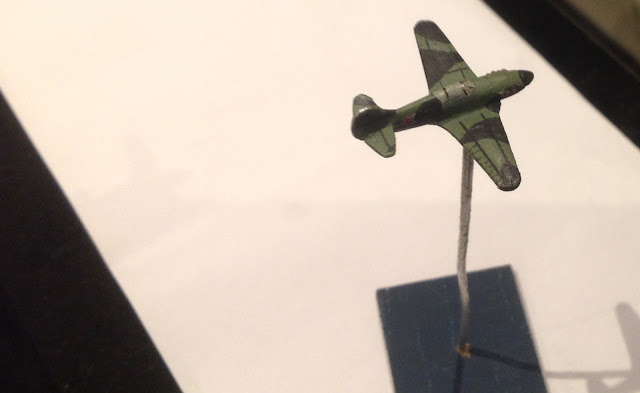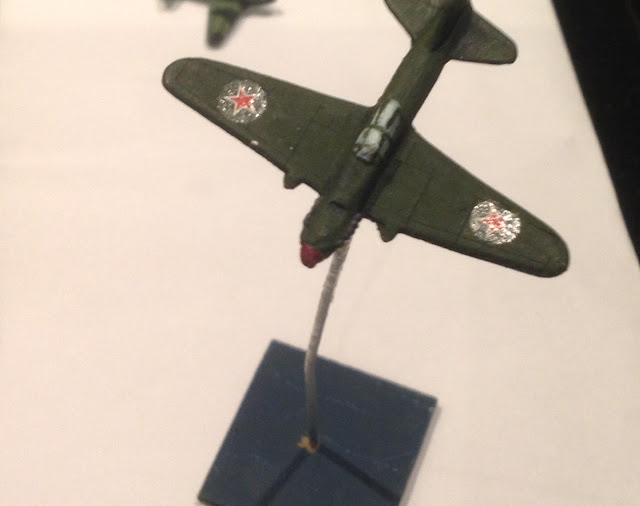It is a tricky business, basing aircraft. By nature, their base has to be planted 'on' the battlefield and yet they have to also be above the battlefield.
I've tried a number of methods - from drilling holes in the aircraft to put the holding wire / strut / whatever into it (and usually for 6mm aircraft drilling right through from the bottom of the aircraft and through the cockpit) to using BluTak or similar.
But now all is ease and comfort with the use of neodymium magnets. They come in a variety of sizes including teeny-tiny which is great for 6mm. I use larger magnets for larger aircraft and smaller magnets for smaller aircraft.
The secret is to find the centre of gravity of the aircraft and stick the magnet there...not much science but it does stop them toppling over...
The really important thing though is to remember the polarity of the magnets and ensure that all the magnets on the aircraft have the opposite polarity to the magnet on the base. Otherwise you will have the heartache of trying to prise a superglued magnet off a plane which then becomes attached to your hand. Or worse you end up with planes that absolutely refuse to sit on the base designed for them and push them away at every opportunity.
Making the bases is fairly straightforward. I use square bases the same sizes of the troop bases in Spearhead (the rule set the aircraft are used for). This allows the bases to line up so you know which plane is attacking which unit. I use a hollow metal tube pushed and glued into a hole drilled into the middle of it.
Make sure the tube is staright - if its at an angle the plane will topple.
Length of tube is quite important as well. Too short and it will look like its about to crash land but too long and it will invariably topple over given the slightest nudge of the table...crashing to its doom. Around 3-4" seems about right. 6" for heavier models is asking for trouble as they will be severely imbalanced.
At the business end of the metal tube I've learned to attach a bead. This is because gluing a magnet to a hollow thin tube does not give much surface area for the glue to gain purchase. The bead just gives a bit more area for the glue to bite on.
Use Superglue (I use Gorilla Gel which is great). Ordinary glue just doesn't cut the mustard.
Once dry on both aircraft and base, its time to try them out. If you have the polarity correct, the plane attaches to the base with a satisfying 'click' saying that you've done a good job.
I've tried a number of methods - from drilling holes in the aircraft to put the holding wire / strut / whatever into it (and usually for 6mm aircraft drilling right through from the bottom of the aircraft and through the cockpit) to using BluTak or similar.
But now all is ease and comfort with the use of neodymium magnets. They come in a variety of sizes including teeny-tiny which is great for 6mm. I use larger magnets for larger aircraft and smaller magnets for smaller aircraft.
 |
| Magnet attached to centre of aircraft. Ignore paintjob - I bought them off Ebay like this and will be repainting in winter colours soon. As the Sturmovich is a heavier plane, I use a larger magnet |
The secret is to find the centre of gravity of the aircraft and stick the magnet there...not much science but it does stop them toppling over...
The really important thing though is to remember the polarity of the magnets and ensure that all the magnets on the aircraft have the opposite polarity to the magnet on the base. Otherwise you will have the heartache of trying to prise a superglued magnet off a plane which then becomes attached to your hand. Or worse you end up with planes that absolutely refuse to sit on the base designed for them and push them away at every opportunity.
Making the bases is fairly straightforward. I use square bases the same sizes of the troop bases in Spearhead (the rule set the aircraft are used for). This allows the bases to line up so you know which plane is attacking which unit. I use a hollow metal tube pushed and glued into a hole drilled into the middle of it.
 |
| Base - not yet painted as it will be done in winter colours. You can see the bead at the top with magnet glued on. Also on the Russian aircraft you can see the smaller size magnet for teeny planes. |
Length of tube is quite important as well. Too short and it will look like its about to crash land but too long and it will invariably topple over given the slightest nudge of the table...crashing to its doom. Around 3-4" seems about right. 6" for heavier models is asking for trouble as they will be severely imbalanced.
 |
| And the right way up. Tube length is just less than 4" |
Use Superglue (I use Gorilla Gel which is great). Ordinary glue just doesn't cut the mustard.
Once dry on both aircraft and base, its time to try them out. If you have the polarity correct, the plane attaches to the base with a satisfying 'click' saying that you've done a good job.
 |
| Larger plane (Sturmovich) on the same stand. As you can see, no problem with stability. |
2 comments:
Some of you may remember that I did this with all my aircraft to use with both check your six and spearhead (my wildcats still have them) and I went back to the drill and stick method for a few reasons . Larger aircraft like the b17 had a centre of gravity directly on ball turret which meant that with the weight of the h & r model seperated the two magnets or the magnet from the model, the aircraft spun around on he magnet and finally on models such as the 109 the magnets looked obtrusive . I even tried sinking the magnet into the model with a large dremel bit to hide them. It's only personal preference like metal stands but having tried it I returned to the old way. You can however have my magnets Phil
If you don't want them, ill have them. Thanks Jono
Post a Comment